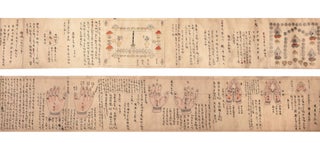“Mizuho no kuni”;
“The Country of Lush Ears of Rice”
Two fine & luxuriously painted scrolls (260 x 4900 mm.; 260 x 4930 mm.) on mica paper, gold-flaked on verso, with gold endpapers at each end of both scrolls, endpapers backed with orig. silk brocade at beginning of each scroll.
[Japan: early mid-Edo].
The theme of the four seasons of rice cultivation has had an extensive presence within Japanese art and literature. These two luxury festive scrolls beautifully depict the year-long cycle of rice growing in Japan, along with the ancillary activities that took place during the year in the countryside, including falconry, growing vegetables and fruits, seasonal festivals, ways of relaxation, and the annual tribute of rice to the fiefdom lord. The activities shown on these scrolls have much in common with Brueghel paintings, and vividly depict country life.
We learn from the labels and handwriting on the original box protecting these two scrolls that they were once owned by two prominent women, members of the famous Nabeshima family. The first owner was Teiju in (1699-1752), wife of Muneshige Nabeshima (1687-1755), fifth lord of the Hizen Kashima han (Hizen Kashima fiefdom). The later owner was Tokusei in (or Kashioka, 1798-1877), widow of Naonori Nabeshima (1793-1826), ninth lord of the same fiefdom. Tokusei in was particularly interested in the development of agriculture of the fiefdom and invented the form of brocading known as Saga nishiki. An educated woman, she was also a book collector, and her library is now kept intact in the Yutoku Inari Shrine in Kashima City in Saga Prefecture. Written on one of the old labels on the box is: “Shiki no kosaku” (“Rice Cultivation through the Four Seasons”).
This type of scroll was oftentimes produced as part of a wealthy bride’s dowery as a symbol of a good harvest and therefore good fortune to the new couple. Another label on the original box states (in trans.): “scroll of images of our territory.”
The scrolls are very richly painted with copious clouds of gold flakes at top and bottom throughout. On both scrolls, the actual images of the ground and background have gold-heightened effects (kinsunago or “golden sand”) or have been painted with gold. The folds and borders of the figures’ clothes are heightened with gold and silver, giving extra nuance. The coloring and detail of each person’s face and clothing is quite refined and subtle, with very delicate and highly detailed tiny brush strokes. We also note that the crowns of the trees have been carefully painted to depict every individual leaf. Clearly, the artist was highly accomplished and went to great lengths to create these scrolls.
SCROLL ONE: The first scroll covers all aspects of spring and summer activities. The first scene is clearly early spring, with the plum trees in blossom. The farmers are preparing the unhulled grains of “seed rice” from last year’s harvest to germinate in preparation for planting this year’s crop. Everyone, from the very young to old, is participating. Many animals, including horses and cows, are in evidence. The next scene shows farmers “waking up” the dry paddies by tilling the soil. The following scene, later in the spring, with cherry blossoms in full bloom, shows the farmers removing the weeds from the dry field and, in an adjacent flooded paddy, planting the rice seeds in the now-prepared seed beds. In the magnificent landscape shown behind, we see a waterfall, demonstrating the freshness of the water soon to flood the fields. Next, we see the farmers planting the seedlings in another paddy, now flooded. The farmers are supported by a band of musicians, who are standing in the adjacent paddy, celebrating the all-important transplantation ritual.
During the summer, water must be continually added to the fields. In the next, extended scene, we see a farmer using a hand-cranked hydraulic device to lift water to the paddies and other farmers tending and weeding the fields during a wind-driven rainstorm. The way the artist subtly depicts the rain reveals his great skills.
The following scene shows a number of farmers and locals celebrating the summer growing period by dancing and playing musical instruments in front of a shrine. They have offered mochi to the shrine, praying for rain and hoping for a good harvest.
The next several scenes show the farmers growing and harvesting vegetables and beans, and picking fruit from large orchards. We see a samurai passing through with his entourage, en route to visit the fiefdom lords.
SCROLL TWO: The second scroll begins by showing more of country life. Farmers are shown delivering vegetables, and a group of samurai are engaged in falconry, accompanied by a considerable entourage. Geese, attracted by the now harvested fields, fly by, clearly intended as the prey of the falcons. There are several farmers fishing by the river, and another group is resting after the day’s work, drinking water. We can sense they are all waiting for the crucial rice harvest.
Now the autumnal harvest season arrives, with a wonderful and complex scene of farmers cutting the rice stalks in the drained fields with sickles. The gathered stalks are bundled into tight sheaves and hung upside-down to dry. Now we see the dried sheaves loaded onto boats for transport. The now-empty paddies are filled with birds picking at the remaining rice kernels. We also see two fishermen catching fish in the river.
In the next scene, the sheaves are stacked before being transported by horse, human, and oxen to another area where the sheaves are further dried. In the following scene, quite complex, we see the rice stalks being processed to separate the rice grains from the shells and then dehusked. The next scene shows the grains of rice laid out on mats to dry. Samurai and farmers are having their own separate picnics, celebrating the harvest. We also see a blind musician being escorted by two friends, a fish monger, and a firewood merchant going to the celebration shown next.
The next scene depicts an elaborate harvest festival, with farmers proceeding to a shrine to give thanks. They are observed by many spectators. The maple trees have turned color to brilliant reds and oranges. Finally, we see farmers carrying their share of taxable rice to the warehouse, where they will present the rice to the heads of the village, who are recording the farmers’ annual tributes in a ledger book. Many rice bales are in evidence.
In fine and fresh condition. There is a minor loss of image at the end of the second scroll where two sheets of paper are joined. Occasional minor worming and discoloration.
Price: $35,000.00
Item ID: 6984


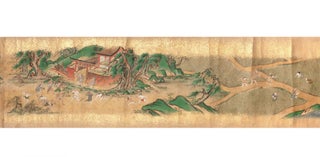
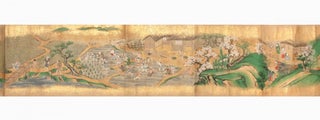
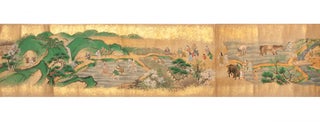
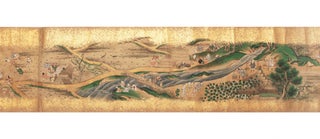
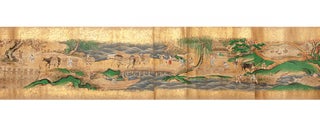
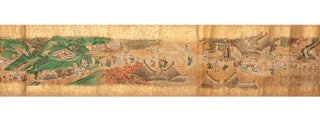

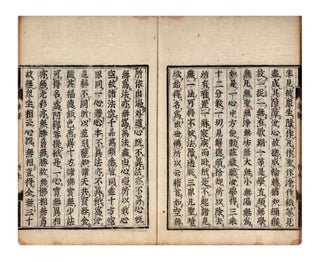
![Pak Ssi ch’irhyŏn kŏŭi rok [or] Pak Ssi chirhyeon geoeui rok. Chae-hwan PAK, Je-hwan or PAK.](https://jonathanahill.cdn.bibliopolis.com/pictures/9425.jpg?width=320&height=427&fit=bounds&auto=webp&v=1694206663)
